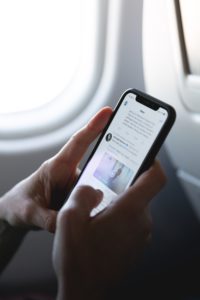Verizon, AT&T, T-Mobile–I hope you are reading this. Mobile telephony, your primary business model of enabling phone calls and text messaging, is dying.
Your internal data likely says otherwise. Growth just appears to be everywhere: 5G’s enhanced mobile broadband speeds are coming alive, more people are subscribing with more gadgets, and some 60% of Americans are in mobile-only households–phenomena that were inconceivable two decades ago. Not to mention, the surge in network use due to the pandemic.
With this kind of growth, why would I say mobile telephony is dying? There are a few good reasons.
Text Messaging and Messaging Apps Reign Supreme
For one, people have stopped calling each other on their phones and are instead messaging. Note that I said messaging, which uses the Internet, and not texting that needs your network.
Messaging is increasingly popular, even preferred. You can be just as professional on it as you can be informal, and express your personality more richly, using emoticons, emojis, memojis, tapbacks, and more. And unlike phone calls, you don’t need to ask about the weather; nor do you need salutations, signatures, or statutory valedictions, as we do with email.
Messaging can be short, unintrusive, and direct. So, it works just as well for messaging colleagues down the hallway, family members in the other room, and friends in faraway places. For the security-minded, leading services are end-to-end encrypted, something that neither traditional texting nor its newer RCS incarceration in Google Messages supports.

Photo by G-R Mottez on Unsplash
Because of this, mobile messaging has been growing exponentially and, following email, accounts for roughly half of all mobile Internet usage. More importantly, 81–80 percent of millennials–the generation that came to age with social media and iDevices–use messaging apps like Facebook Messenger on mobile devices.
People Prefer Video Calls Instead of Phone Calls
Secondly, when people do call, they increasingly use video rather than voice, especially for making group calls. Video calling showed an estimate 175 percent increase in usage in the last 3 years, with one in four millennials using it on a daily basis. And this was before the pandemic made it a necessity and ushered in newer, arguably easy to use, apps such as Zoom, and made group calls for work, school, even television interviews, mainstream. While group video calls can be made on mobile devices, they are better on larger-screened laptops and tablets, which is bad news if you are a cellular provider–because none of these, again, require your service.
Not so long ago, the cellular providers dictated what people could use on their network. Today, the power has shifted to the gadget makers who provide the cameras, the noise-canceling earphones, the ability to seamless switch between devices when making video calls–and shape the experience. Because of this, the mobile phone number is becoming less important, while the device and how well it can sync-up with other devices owned by the user, is central to the user’s quality of experience.
Finally making things worse is that cellular networks have not been able to stem abuse on their network. Already in 2020, 58 billion robocalls were made to American residents’ mobile phone, for an average 80.6 calls per person — and this was a 22 percent increase over the previous year. Many are phishing calls and texts that appear to come from local area codes and are attempts at deceiving users into paying fraudulent IRS dues, threatening various dire legal actions, or luring users into opening malicious hyperlinks in text messages.
Phishing And Robocalls Deteriorates Trust In Cellular-Based Calling
Phishing is made possible by Internet-based telephony, which makes it possible for attacks to be fomented from anywhere in the world and avoid prosecution. Also enabling them is our caller-ID system, which was originally developed for the home phone network when there were few providers who could all be trusted. Caller-ID’s thus assumed all callers were honest and displayed whatever number was programmed in by them. Today, this makes it possible for anyone using computerized phone-dialers to obfuscate the true source of phone calls and fake the phone numbers that show up on our caller IDs.
The phone carriers, however, don’t recognize the nuisance these calls cause. So, even though they have developed apps to block such calls, they charge an additional fee for them. But consumers, long sold on different cellular networks’ delivery quality with “Can you hear me now?” promises, are unwilling to pay for something they believe should be dealt with by the carriers. Thus, rather than pay for the app, users keep their mobile devices on silent-mode, ignoring incoming calls and texts. For many millennials, this likely furthers their shift to messaging and video calling.
The risk of being silenced, especially by this important consumer psychographic, could have a profound impact on the future of the cellular network. In the past, consumers in similar age cohorts have shown to be relatively quick in moving away from services that didn’t consider their interests ahead of the organization’s bottom-line.
Much like cellular networks today, back in the 1990s, the home phone networks reigned supreme. Their primary business was long distance, for which they kept charging exorbitantly. In 1997, long-distance rates at 12–25 cents per minute, up 25 percent since 1992. The future looked so bright that the former head of AT&T’s long-distance, Joseph P. Nacchio, remarked: “Long distance is still the most profitable business in America, next to importing illegal cocaine.”

Photo by Hansjörg Keller on Unsplash
At the time, there were just 50 million mobile subscribers, all of who also had a home phone. Within a few years, that generation of 22–40-year old’s quickly adopted Internet and mobile telephony, which all but killed the traditional phone business.
Today’s millennials are not only in the same age cohort but they are also now the majority of American residents. They have already dropped their home phones for mobile, and their cable subscriptions for streaming video. Their cellular phone plans may well be next.
*A version of this post appeared here: https://blog.ipswitch.com/mobile-telephony-is-dying-heres-why

